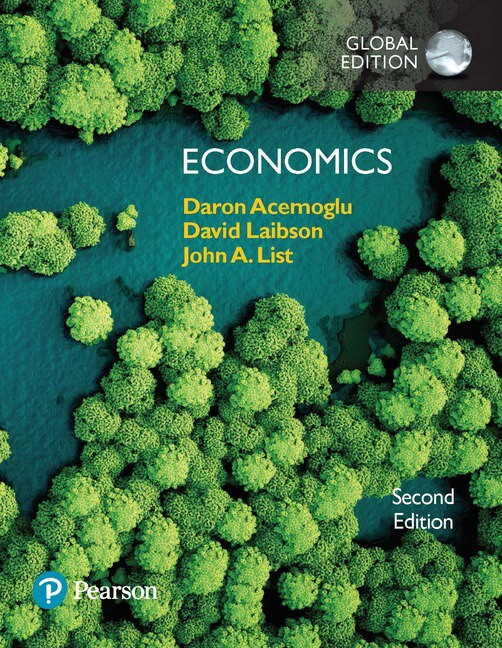Учебник Economics, Global Edition
Характеристики:
Сторінок:
832
Год издания:
Издательство:
Переплет:
ISBN:
9781292214504
Заказ
Доставка
Оплата
Учебник Economics, Global Edition
Нет в наличии
2295 грн
Самовывоз:
Бесплатно
КИЕВ. ул. Митрополита Андрея Шептицкого, 14 (офис Dinternal Education)
Бесплатно
Самовывоз из Новой почты:
По тарифам служби доставки (на заказы от 2000 грн - бесплатно)
Курьером Новой Почты
За тарифами служби доставки
Наличный расчет
Онлайн оплата LiqPay
Оплата при доставке
Безналичная оплата для физических и юридических лиц
Описание товара
Отзывы (0)
Real issues engage students with the content
- Examination of causality. By studyingrecent research that reports a positive correlation between expensive weddings and high rates of divorce, students will learn to determine the difference between correlation and causality, and better understand the role of omitted variables (Chapter 2).
- Coverage of the fracking revolution and its impact on oil and gas prices. Supply and demand come alive when students can see how the recent rightward shift in the oil supply curve--due to the development of fracking technologies--has played a role in halving the equilibrium price of oil (Chapter 4).
- Focus on the shared economy. The role of surge pricing in equilibrating Uber driver supply and rider demand is discussed, helping students to more deeply understand the markets that they personally use (Chapter 7).
- Emphasis on the role of microeconomics in examining prominent social issues. From natural disaster management to global inequality, students examine important social issues–such as how to reduce fracking-generated earthquakes by applying the concept of externalities, inequality in Scandinavia, broadband access, and more.
- Coverage of the recent election to teach topics like probability. Students use analytic tools to understand how to interpret forecasts on the eve of the election (Chapter 15).
- Coverage describing the growth of economic inequality, and emphasizing that inequality is not measured in economic aggregates, such as GDP (Chapter 19).
An evidence based approach using real issues and data
- Evidence-Based Economics (EBE) features show how economists use data to answer the question posed in the opening paragraph of each chapter. EBEs use actual data from field experiments, lab experiments, and the government or naturally occurring data, while highlighting major concepts in the chapter. These features let students get a real look at economics as it plays out in the world around them, and gives them the skills to question systematically and evaluate what they read. Examples include:
- Uber and the invisible hand?
- What can the government do to lower earthquakes in Oklahoma?
- Letting the Data Speak features reinforce the theme of evidence behind the theory. These short, targeted explorations analyze an economic question by using real data as the foundation of the discussion. Among the many issues explored:
- Forecasts on the eve of the election
- The great productivity puzzle--discussing how we may be experiencing a slow-down of aggregate productivity despite the rapid introduction of a range of new technologies in the economy (Chapter 21)
- Democracy and growth, showing the positive impact of democratic political institutions on economic growth (Chapter 22)
- Financing start-ups (Chapter 24)
- The response of consumption to tax cuts (Chapter 27)
- Choice and Consequence features emphasize optimization--one of the key themes in the book--by focusing on making the best decision. These features ask students to make an economic decision, or evaluate the consequences of past real decisions. The authors then explain how an economist might analyze the same decision. Examples of choices investigated include:
- The societal consequences of the expulsion of Jewish faculty from universities in Nazi Germany (Chapter 20)
- Minimum wage laws and employment (Chapter 23)
- Luddite resistance to new technology and what this can teach us about the disruption that new and more productive robots are bringing to the economy today (Chapter 23)
- Obtaining reserves outside of the federal funds market (Chapter 25)
- The new administration’s fiscal policy proposals (Chapte
Table of Contents
PART I: INTRODUCTION TO ECONOMICS
1. The Principles and Practice of Economics
2. Economic Methods and Economic Questions
3. Optimization: Doing the Best You Can
4. Demand, Supply, and Equilibrium
PART II: FOUNDATIONS OF MICROECONOMICS
5. Consumers and Incentives
6. Sellers and Incentives
7. Perfect Competition and the Invisible Hand
8. Trade
9. Externalities and Public Goods
10. The Government in the Economy: Taxation and Regulation
11. Markets for Factors of Production
PART III: MARKET STRUCTURE
12. Monopoly
13. Game Theory and Strategic Play
14. Oligopoly and Monopolistic Competition
PART IV: EXTENDING THE MICROECONOMIC TOOLBOX
15. Trade-offs Involving Time and Risk
16. The Economics of Information
17. Auctions and Bargaining
18. Social Economics
PART V: INTRODUCTION TO MACROECONOMICS
19. The Wealth of Nations: Defining and Measuring Macroeconomic Aggregates
20. Aggregate Incomes
PART VI: LONG-RUN GROWTH AND DEVELOPMENT
21. Economic Growth
22. Why Isn’t the Whole World Developed?
PART VII: EQUILIBRIUM IN THE MACROECONOMY
23. Employment and Unemployment
24. Credit Markets
25. The Monetary System
PART VIII: SHORT-RUN FLUCTUATIONS AND MACROECONOMIC POLICY
26. Short-Run Fluctuations
27. Countercyclical Macroeconomic Policy
PART IX: MACROECONOMICS IN A GLOBAL ECONOMY
28. Macroeconomics and International Trade
29. Open Economy Macroeconomics
Здесь пока никто ничего не написал. Будь первым!
Для того, чтобы оставить отзыв авторизуйтесь
Схожі товари

Автор: J. J. Wilson
Есть в наличии
1000 грн

Автор: Gareth Rees
Есть в наличии
1235 грн
850 грн











